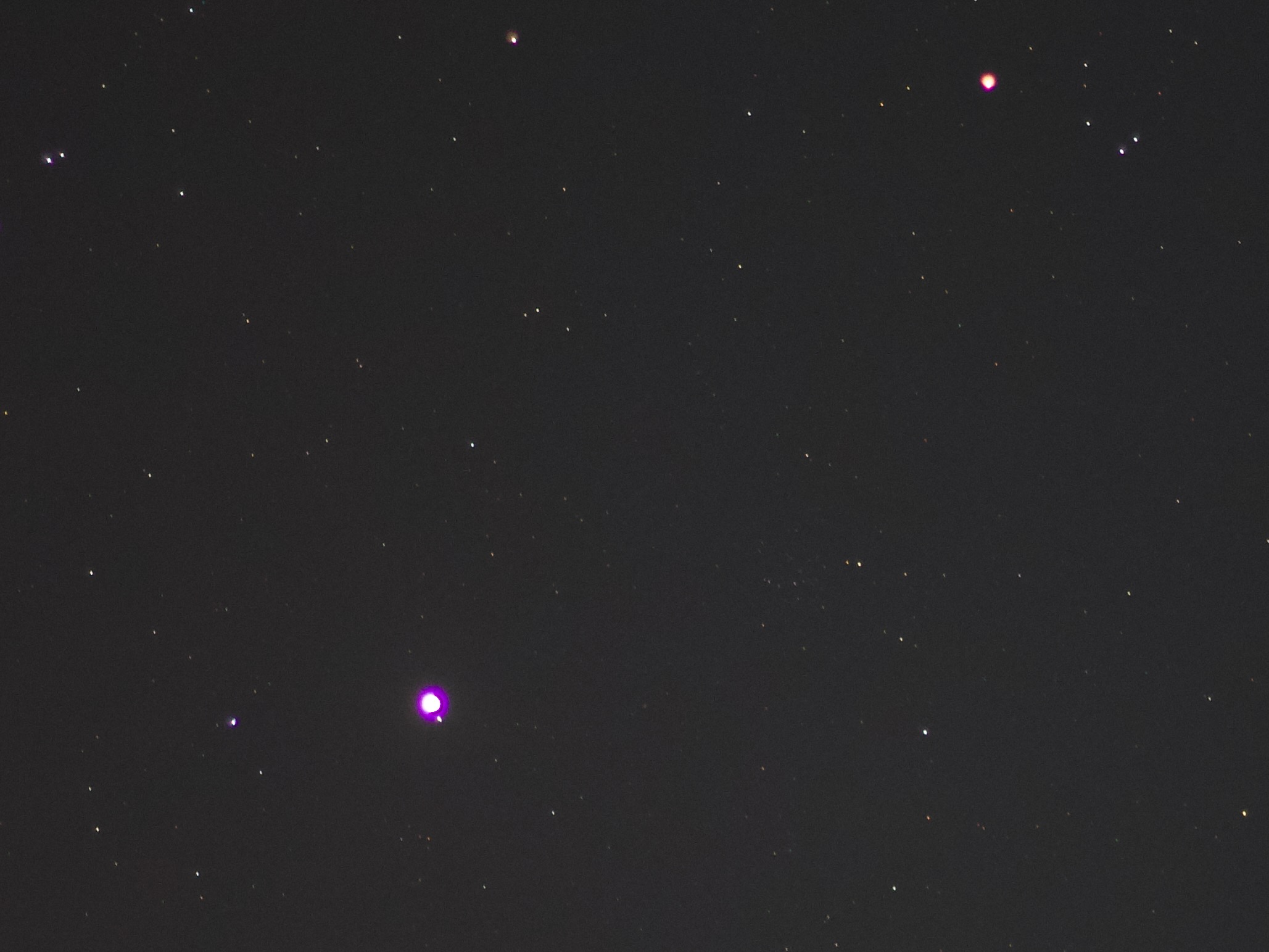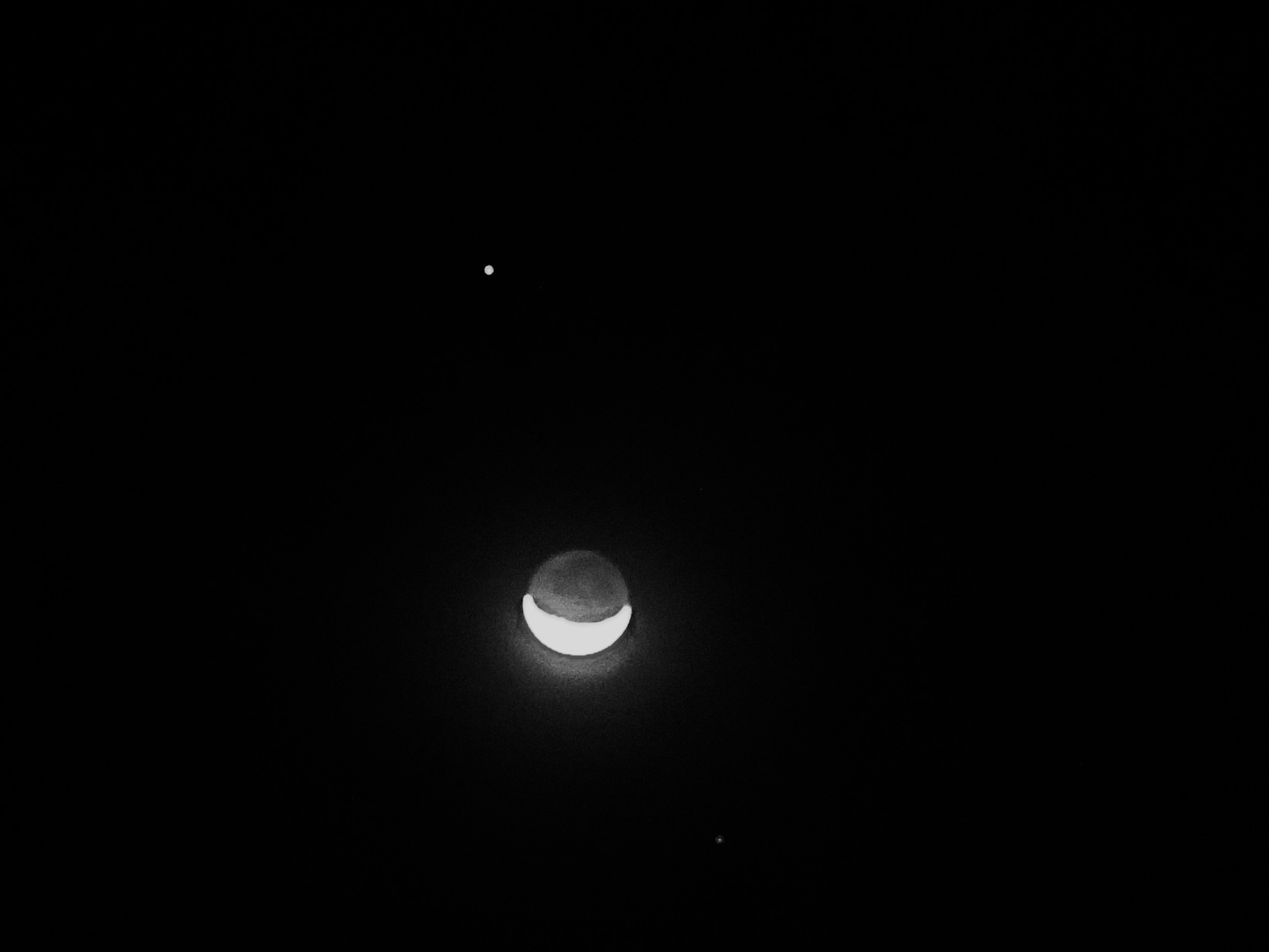Today we’re gonna talk about my relationship with astronomy and stargazing, and how you can recognize these beautiful celestial bodies yourself.
What is Astronomy?
Astronomy comes from the greek words astro meaning star and -nomia meaning law or culture. So it quite literally translates to law of stars or culture of stars. It refers to the study of celestial objects. A professional astronomer is someone that studies celestial objects for a living, collecting data about them, formulating theories on how they came to be, and providing the rest of the world with information that blow our minds on the regular. Did you know Saturns rings aren’t that old at all? In fact, there were sharks in our oceans before Saturn had it’s iconic rings. There were probably whole generations of sharks that could’ve seen Saturn naked. Isn’t that crazy? That’s honestly more credit to sharks than it is to Saturn, but I digress.
 Here’s a picture my friend, Manas, and I got on 2025-01-04. The purple blob you see is Jupiter, the biggest planet in the solar system, and one of its Galilean moons, I couldn’t figure out which one. (Comment if you know!) The red dot on the top right is Aldebaran, the brightest star in the Taurus constellation.
Here’s a picture my friend, Manas, and I got on 2025-01-04. The purple blob you see is Jupiter, the biggest planet in the solar system, and one of its Galilean moons, I couldn’t figure out which one. (Comment if you know!) The red dot on the top right is Aldebaran, the brightest star in the Taurus constellation.
Why Do I Care?
Honestly, I don’t know. Ever since I was young I have been fascinated with outer space and all the shiny dots in the sky. I remember going through encyclopedias and picture books, going through pictures of stars and nebulae, reading up on how stars are born and how they die. The first star I learnt to identify was Sirius, the dog star, the brightest star in the night sky. I remember going out into my balcony with my dad’s binoculars, trying to see the moon and the stars up close, and failing miserably because, well, the binoculars weren’t strong enough. Then I learned about Venus, also known as the morning or evening star, named so because it is the brightest (and usually only) celestial object in the sky (except the Sun and the Moon) during sunsets and sunrises. It always fascinated me, learning about the names of these stars and planets, thinking about how many people are looking up into the sky with me, how many people have looked up at the same sky over the existence of humanity.
 Here’s a picture of the Moon and the planet Saturn we got on the same day.
Here’s a picture of the Moon and the planet Saturn we got on the same day.
What Now?
Fast forward to the summer of 2024, I got my hands on the iPhone 13, and while browsing the app store, I can across this interesting app, Sky Guide. It showed me the night sky and all the stars, planets, constellations and clusters that I could see. I’d occasionally pull it out and check out the sky whenever I’m out, and spot a few familiar faces like Venus or Jupiter or sometimes even Mars. This is slowly reignited my love for stargazing, motivating me to go on walks every day to the open ground on campus, and look at the night sky, see what cool stars and planets are visible today. Jupiter and Venus are the usual brightest guys in the sky, and I’d take a few pictures of them on my phone and occasionally add them to my Instagram or show them to my family when we talk on the phone. I started going there almost every night, showing the dots on the night sky to my friends.
Soon Manas and I started going stargazing together, looking at the night sky for a few minutes and snagging a few pictures on our phones. Yesterday, after a lot procrastination, we took his camera out to the ground to get some good pictures of the night sky. Took us a while to get the settings right, but damn it did we get pictures! We got pictures of Mars, Sirius, the Moon, Saturn and even Jupiter with one of its moons! It was honestly life changing to see the night sky so full of bright dots of so many colors. Brought back so many emotions from my childhood, made me feel like a kid again, looking at those encyclopedias. It was a beautiful experience and I want you to have it too. So I’m gonna tell you how.
 Same day. The red dot is Mars, the 4th planet from the Sun.
Same day. The red dot is Mars, the 4th planet from the Sun.
How Can You See It?
Here’s a guide to identifying famous stars, planets and constellation on the night sky with your naked eyes. (Clear sky required for most)
Venus
Venus is the 2nd planet from the Sun in the Solar System and can be seen shining bright in the sky during sunrises or sunsets on most if not all days.
Jupiter
Jupiter, the larges planet in the solar system, is usually the brightest thing in the sky. One neat trick to see if you’re looking at a planet or a star is to see if it twinkles, only stars twinkle. It’s usually visible the whole night, showing up straight above you, unlike Venus which would be more by the horizon at that time.
The Orion Constellation
This is my favorite constellation, because it’s the only one I can identify in the night sky. Look for 3 stars in a straight line, it’s hard to miss. Those three stars are known as Orion’s Belt. It’s usually visible in January, but not exclusively. Refer to this picture to get an idea of where the rest of Orion lies. This leads me to the brightest star in the constellation,
Betelgeuse
Pronounced beetle-juice, this is the brightest star in the Orion constellation. It’s a red supergiant star, and is the 10th brightest star in the night sky. I included it here because of it’s funny name lol.
Sirius
Sirius, the dog star, is the brightest star in the night sky. I used to confuse Sirius with Jupiter a lot, because Jupiter is usually the brightest object in the sky. But like I said, stars twinkle, planets don’t. Fun fact: it’s about 9 light years away. So the Sirius you’re seeing from here is actually how it looked 9 years ago.
Mars
Mars is easy to spot, but is also a rare find in the night sky. It’s the only red object in the night sky that will not twinkle. So be on the lookout for that.
Bonus: Picture guide
To get a semi decent picture of any of the above, all you need is a relatively newer phone which has night mode photography. Point your camera at the night sky and click a picture. Hold your phone as still as possible during the photo. If there’s a lot of light pollution or things aren’t bright enough, use the edit option to crank up the contrast and lower the brightness.
Hope you get clear skies and starry nights! 🌌🪐🔭